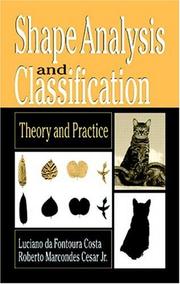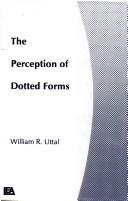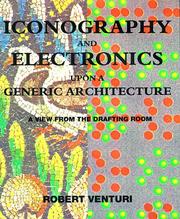| Listing 1 - 10 of 20 | << page >> |
Sort by
|
Book
ISBN: 2880780136 Year: 1990 Publisher: Neuchâtel Musée d'ethnographie de Neuchâtel
Abstract | Keywords | Export | Availability | Bookmark
 Loading...
Loading...Choose an application
- Reference Manager
- EndNote
- RefWorks (Direct export to RefWorks)
Ethnology. Cultural anthropology --- #VCV monografie 2006 ruil --- Holes --- -Form perception --- Form discrimination --- Shape discrimination --- Shape perception --- Perception --- Visual perception --- Figure-ground perception --- Apertures --- Cavities --- Openings (Holes) --- Orifices --- Perforations --- Pits (Holes) --- Surfaces --- Psychological aspects --- Form perception
Book
ISBN: 047089654X Year: 1975 Publisher: Hillsdale, N.J. : L. Erlbaum Associates,
Abstract | Keywords | Export | Availability | Bookmark
 Loading...
Loading...Choose an application
- Reference Manager
- EndNote
- RefWorks (Direct export to RefWorks)
Form perception --- Perception des formes --- 316.77 --- #SBIB:309H505 --- Form discrimination --- Shape discrimination --- Shape perception --- Perception --- Visual perception --- Figure-ground perception --- Communicatiesociologie --- Code en boodschap: psychologische, psycho-analytische benadering --- Form perception. --- 316.77 Communicatiesociologie
Book
ISBN: 0125912501 Year: 1973 Publisher: New York (N.Y.): Academic press
Abstract | Keywords | Export | Availability | Bookmark
 Loading...
Loading...Choose an application
- Reference Manager
- EndNote
- RefWorks (Direct export to RefWorks)
Affective and dynamic functions --- Form perception --- Orientation --- Visual Perception --- Orientation (Psychology) --- Perception des formes --- Orientation (Psychologie) --- 159.93 --- Geographical perception --- Instinct --- Psychology --- Senses and sensation --- Spatial behavior --- Form discrimination --- Shape discrimination --- Shape perception --- Perception --- Visual perception --- Figure-ground perception --- Zintuiglijke waarnemingen --- Form perception. --- Orientation. --- Visual perception. --- Orientation (Psychology). --- 159.93 Zintuiglijke waarnemingen --- Form Perception. --- Visual Perception.
Book
ISBN: 0124478506 Year: 1981 Publisher: London Academic press
Abstract | Keywords | Export | Availability | Bookmark
 Loading...
Loading...Choose an application
- Reference Manager
- EndNote
- RefWorks (Direct export to RefWorks)
Perception --- Form perception --- Psychophysics --- Perception des formes --- Psychophysique --- Research --- Recherche --- 159.93 --- -Form perception --- -Psychophysics --- Physics --- Psychophysiology --- Form discrimination --- Shape discrimination --- Shape perception --- Visual perception --- Figure-ground perception --- Supraliminal perception --- Cognition --- Apperception --- Senses and sensation --- Thought and thinking --- Zintuiglijke waarnemingen --- 159.93 Zintuiglijke waarnemingen --- Research.

ISBN: 0849334934 9780849334931 Year: 2001 Publisher: Boca Raton, FL : 2001 CRC Press
Abstract | Keywords | Export | Availability | Bookmark
 Loading...
Loading...Choose an application
- Reference Manager
- EndNote
- RefWorks (Direct export to RefWorks)
Form perception --- Image analysis --- Image processing --- Digital techniques --- Form perception. --- Image analysis. --- Digital techniques. --- Digital image processing --- Digital electronics --- Form discrimination --- Shape discrimination --- Shape perception --- Perception --- Visual perception --- Figure-ground perception --- Analysis of images --- Image interpretation --- Photographs --- Forensic sciences --- Imaging systems --- Inspection --- Image processing - Digital techniques

ISBN: 0898599296 Year: 1987 Publisher: Hillsdale Erlbaum
Abstract | Keywords | Export | Availability | Bookmark
 Loading...
Loading...Choose an application
- Reference Manager
- EndNote
- RefWorks (Direct export to RefWorks)
Form Perception. --- Visual Perception. --- Dots (Art) --- -Form perception --- Form discrimination --- Shape discrimination --- Shape perception --- Perception --- Visual perception --- Figure-ground perception --- Art --- Perception, Visual --- Perceptions, Visual --- Visual Perceptions --- Vision, Ocular --- Contour Perception --- Contour Perceptions --- Form Perceptions --- Perception, Contour --- Perception, Form --- Perceptions, Contour --- Perceptions, Form --- Contrast Sensitivity --- Psychological aspects --- Form perception. --- Psychological aspects. --- Form perception --- Form Perception --- Visual Perception --- Visual Processing --- Processing, Visual
Book
ISBN: 026251513X 0262162512 9786612099472 0262281651 1282099477 143564073X 9780262162517 9780262281652 9781435640733 9780262293020 0262293021 9781282099470 661209947X 9780262515139 Year: 2008 Publisher: Cambridge, Mass. MIT Press
Abstract | Keywords | Export | Availability | Bookmark
 Loading...
Loading...Choose an application
- Reference Manager
- EndNote
- RefWorks (Direct export to RefWorks)
A new account of how we perceive the 3D shapes of objects and how to design machines that can see shapes the way we do.
Form perception --- Visual perception --- Perception --- Space Perception --- Visual Perception --- Mental Processes --- Psychological Phenomena and Processes --- Psychiatry and Psychology --- Form Perception --- Social Sciences --- Psychology --- Form perception. --- Visual perception. --- Optics, Psychological --- Vision --- Form discrimination --- Shape discrimination --- Shape perception --- Psychological aspects --- Visual discrimination --- Figure-ground perception --- NEUROSCIENCE/Visual Neuroscience --- COGNITIVE SCIENCES/General

ISBN: 0262220512 0262285355 0585360278 Year: 1996 Publisher: Cambridge, Mass. : MIT Press,
Abstract | Keywords | Export | Availability | Bookmark
 Loading...
Loading...Choose an application
- Reference Manager
- EndNote
- RefWorks (Direct export to RefWorks)
In this book, Shimon Ullman focuses on the processes of high-level vision that deal with the interpretation and use of what is seen in the image. In particular, he examines two major problems. The first, object recognition and classification, involves recognizing objects despite large variations in appearance caused by changes in viewing position, illumination, occlusion, and object shape. The second, visual cognition, involves the extraction of shape properties and spatial relations in the course of performing visual tasks such as object manipulation, planning movements in the environment, or interpreting graphical material such as diagrams, graphs and maps. The book first takes up object recognition and develops a novel approach to the recognition of three-dimensional objects. It then studies a number of related issues in high-level vision, including object classification, scene segmentation, and visual cognition. Using computational considerations discussed throughout the book, along with psychophysical and biological data, the final chapter proposes a model for the general flow of information in the visual cortex. Understanding vision is a key problem in the brain sciences, human cognition, and artificial intelligence. Because of the interdisciplinary nature of the theories developed in this work, High-Level Vision will be of interest to readers in all three of these fields.
architectuurtheorie --- Architecture --- architectural theory --- anno 1900-1999 --- Architecture, Modern --- Philosophy --- Philosophie --- Robert Venturi °1925 (°Philadelphia) --- Architectuurtheorie ; 20ste eeuw ; R. Venturi --- Architectuur ; iconologie ; betekenis --- 72.01 --- Architectuur ; theorie, filosofie, esthetica --- History --- Visual perception. --- NEUROSCIENCE/Visual Neuroscience --- COGNITIVE SCIENCES/General --- 72.07 --- Venturi, Robert 1925-2018 (°Philadelphia, Verenigde Staten) --- Architecten. Stedenbouwkundigen --- Optics, Psychological --- Vision --- Perception --- Visual discrimination --- Psychological aspects --- Form perception. --- Form discrimination --- Shape discrimination --- Shape perception --- Visual perception --- Figure-ground perception
Book
Year: 2021 Publisher: Basel, Switzerland MDPI - Multidisciplinary Digital Publishing Institute
Abstract | Keywords | Export | Availability | Bookmark
 Loading...
Loading...Choose an application
- Reference Manager
- EndNote
- RefWorks (Direct export to RefWorks)
Today in many studies, mental images are still either treated as conscious by definition, or as empirical operations implicit to completing some type of task, such as the measurement of reaction time in mental rotation, an underlying mental image is assumed, but there is no direct determination of whether it is conscious or not. The vividness of mental images is a potentially helpful construct which may be suitable, as it may correspond to consciousness or aspects of the consciousness of images. In this context, a complicating factor seems to be the surprising variety in what is meant by the term vividness or how it is used or theorized. To fill some of the gaps, the goal of the present Special Issue is to create a publication outlet where authors can fully explore through sound research the missing theoretical and empirical links between vividness, consciousness and mental imagery across disciplines, neuroscience, psychology, philosophy, cognitive science, to mention the most obvious ones, as well as transdisciplinary methodological (single, combined, or multiple) approaches.
Psychology --- vividness --- mental imagery --- consciousness --- cognitive neuroscience --- neuroimaging --- cognitive psychology --- behavior --- verbal report --- phenomenology --- perception --- DMN --- TPN --- familiarity --- memory --- amodal completion --- shape perception --- perceptual organization --- depth perception --- visual illusions --- color-gustatory synesthesia --- taste --- taste modulator --- synesthesia --- bibliometrics --- map of science --- term co-occurrence --- contrast polarity --- simplicity principle --- likelihood principle --- simplicity–likelihood equivalence --- Bayes --- classical information theory --- modern information theory --- Bayes’ framework --- visual imagery --- stroke --- posterior cerebral artery --- aphantasia --- prosopagnosia --- visual perception --- n/a --- simplicity-likelihood equivalence --- Bayes' framework
Book
Year: 2021 Publisher: Basel, Switzerland MDPI - Multidisciplinary Digital Publishing Institute
Abstract | Keywords | Export | Availability | Bookmark
 Loading...
Loading...Choose an application
- Reference Manager
- EndNote
- RefWorks (Direct export to RefWorks)
Today in many studies, mental images are still either treated as conscious by definition, or as empirical operations implicit to completing some type of task, such as the measurement of reaction time in mental rotation, an underlying mental image is assumed, but there is no direct determination of whether it is conscious or not. The vividness of mental images is a potentially helpful construct which may be suitable, as it may correspond to consciousness or aspects of the consciousness of images. In this context, a complicating factor seems to be the surprising variety in what is meant by the term vividness or how it is used or theorized. To fill some of the gaps, the goal of the present Special Issue is to create a publication outlet where authors can fully explore through sound research the missing theoretical and empirical links between vividness, consciousness and mental imagery across disciplines, neuroscience, psychology, philosophy, cognitive science, to mention the most obvious ones, as well as transdisciplinary methodological (single, combined, or multiple) approaches.
Psychology --- vividness --- mental imagery --- consciousness --- cognitive neuroscience --- neuroimaging --- cognitive psychology --- behavior --- verbal report --- phenomenology --- perception --- DMN --- TPN --- familiarity --- memory --- amodal completion --- shape perception --- perceptual organization --- depth perception --- visual illusions --- color-gustatory synesthesia --- taste --- taste modulator --- synesthesia --- bibliometrics --- map of science --- term co-occurrence --- contrast polarity --- simplicity principle --- likelihood principle --- simplicity–likelihood equivalence --- Bayes --- classical information theory --- modern information theory --- Bayes’ framework --- visual imagery --- stroke --- posterior cerebral artery --- aphantasia --- prosopagnosia --- visual perception --- n/a --- simplicity-likelihood equivalence --- Bayes' framework
| Listing 1 - 10 of 20 | << page >> |
Sort by
|

 Search
Search Feedback
Feedback About
About Help
Help News
News